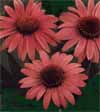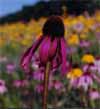 Wildflower Gardening is a must for those gardeners interested in attracting wildlife. Whether your interest lies with butterflies, moths, birds or other critters the surest way to attract them into your gardens is by planting what is familiar to them. No self respecting White-Tailed Deer would be caught dead in a bamboo cane break. Also you would not find many American Bullfrogs feeding on insects in a sunny cacti garden. If you provide wildlife with the right food and shelter they will come.
Wildflower Gardening is a must for those gardeners interested in attracting wildlife. Whether your interest lies with butterflies, moths, birds or other critters the surest way to attract them into your gardens is by planting what is familiar to them. No self respecting White-Tailed Deer would be caught dead in a bamboo cane break. Also you would not find many American Bullfrogs feeding on insects in a sunny cacti garden. If you provide wildlife with the right food and shelter they will come.
Some gardeners worry about wildlife doing damage to their plants. Unfortunately, many uninformed gardeners actually go to great lengths to discourage natures critters. We have found that if you provide plants that wildlife naturally feed on, they will do little damage to your other garden plants. Sure you might have a few plants nibbled on, particularly in times of stress, but this is a small price to pay for having wildlife around.
Last Spring we were fortunate to have twin White-tailed Deer born in our wetland area. We watched the “twins” grow from cute little spotted fawns to full size deer through the Summer. Some of our plants became a little tattered from their nibbling and we definitely did not have to cut back our roses in the Fall, but what fun we had watching them grow up. We would not have traded the experience for all the plants in our gardens.
 Similarly, the Monarch Butterfly larva can eat a lot of Pink Swamp Milkweed foliage, but what wonder it is to watch an adult emerge from its Chrysalis. We are only too happy to see butterfly and moth larva feeding on our wildflowers as we know soon adults will be drifting about laying more eggs for the next generation.
Similarly, the Monarch Butterfly larva can eat a lot of Pink Swamp Milkweed foliage, but what wonder it is to watch an adult emerge from its Chrysalis. We are only too happy to see butterfly and moth larva feeding on our wildflowers as we know soon adults will be drifting about laying more eggs for the next generation.
 How we remember the times when pesticides were so over used that it was rare to see any butterflies and moths. Fortunately, today we realize how important all of natures creatures are and how they interact with each other. Knowledgeable gardeners now plant to encourage their presents, and why not, what would gardening be without them.
How we remember the times when pesticides were so over used that it was rare to see any butterflies and moths. Fortunately, today we realize how important all of natures creatures are and how they interact with each other. Knowledgeable gardeners now plant to encourage their presents, and why not, what would gardening be without them.
Fortunately Wildflower Gardening has enjoyed an increase in popularity as gardeners have discovered their importance and how to use them effectively. Wildflowers are not only finding their way into the traditional garden but, are being used increasingly as a replacement for the traditional lawn, all but eliminating mowing. States are turning to wildflowers along highways to reduce maintenance costs. While large well groomed lawns and roadsides may be attractive to some, they are actually a very barren natural environment.
Successful urban wildflower gardening requires careful planning, soil preparation, and seeding. Pick your site carefully. Make sure that the area receives plenty sunlight, 6-8 hours for most wild plants. Usually site preparation will take one to two years using a combination of cultivation and herbicide applications to eliminate existing growth, roots, and weed seeds.
Your task will be made easier if you choose a site that does not border areas of aggressive weedy plants. You will also have to allow for the soil type in site selection. For example, many plants hate heavy clay soils while others cannot stand to have their feet wet.
Select a variety of wildflowers including some of our native grasses. You want to have a variety, not only for color but to maintain bio-diversity. By providing plants occupying different parts of the soil, you help insure that wildflowers will squeeze out competing weeds. This is one of the secrets to having a low maintenance garden.
 While wildfowers have become more widely available today, do not expect to buy a packet of seeds at the corner drugstore, sprinkle them around, and magically have a field of flowers. By all means avoid buying seed at your local nursery unless you know that they specialize in wildflower gardening. Most pre-packaged seeds are not worth the effort to plant. It might be nostalgic to use “North Manitou Island Wildflowers” or “Yellowstone’s Buffalo Blend”, but the chances of the seeds growing into something beautiful are slim.
While wildfowers have become more widely available today, do not expect to buy a packet of seeds at the corner drugstore, sprinkle them around, and magically have a field of flowers. By all means avoid buying seed at your local nursery unless you know that they specialize in wildflower gardening. Most pre-packaged seeds are not worth the effort to plant. It might be nostalgic to use “North Manitou Island Wildflowers” or “Yellowstone’s Buffalo Blend”, but the chances of the seeds growing into something beautiful are slim.
Make your seed selection carefully. Look not only for flower type but also purity of seed. We recommend using nothing less then 95% pure seeds. We strongly suggest that you visit Prairie Nursery and Wildseed Farms web sites before starting. Both sites have a tremendous amount of helpful information on site selection, preparation, and plant selection. Both sell top quality seeds that the home gardener can depend on.
With a little planning and some up-front work, you too can have something that will last for years with little maintenance. We consider wildflowers just that, native plants for the wildlife to enjoy. Hopefully, we all have had our enjoyment out of them. If they are tattered, worm eaten, and grazed over by the end of the season it really does not matter. The butterflies, birds, and other wildlife will love you too. We know that the “Twins” sure loved our roses.
Tips of the Month
Wildflowers come in many shapes and colors, what is found growing in one part of the word as wild is probably being cultivated somewhere else. Many of our native plants have made the jump from being called weeds to being nurtured as prize specimen plants. Probably this is not better illustrated than the life of our native prairie Coneflowers and Black-Eyed Susan. We recommend the following plants, all of which can be found in our Plant Data Base:
 Echinacea pallida Pale Purple Coneflower blooms in early summer, 2-3 inch, pale-lavender, slender ray flowers droop gracefully on this lance-leaved prairie native.
Echinacea pallida Pale Purple Coneflower blooms in early summer, 2-3 inch, pale-lavender, slender ray flowers droop gracefully on this lance-leaved prairie native. Echinacea pupurea Rubinstern is a medium tall coneflower with glowing red flowers with horizontal petals on robust plants. Stands out immediately when first seen.
Echinacea pupurea Rubinstern is a medium tall coneflower with glowing red flowers with horizontal petals on robust plants. Stands out immediately when first seen. Echinacea purpurea Fragrant Angel is a white coneflower that others can only aspire to. Grows just like ‘Ruby Giant’, with large, fragrant, and horizontal flowers with layered, overlapping petals and huge yellow cones.
Echinacea purpurea Fragrant Angel is a white coneflower that others can only aspire to. Grows just like ‘Ruby Giant’, with large, fragrant, and horizontal flowers with layered, overlapping petals and huge yellow cones. Echinacea purpurea Magnus is a native found in open woods and on prairies. It grows to three feet in height and has long stiff stems with one large cone with showy purple ray flowers.
Echinacea purpurea Magnus is a native found in open woods and on prairies. It grows to three feet in height and has long stiff stems with one large cone with showy purple ray flowers. Echinacea purpurea Art’s Pride is a coneflower comes from the breeding program of Dr. Jim Ault of the Chicago Botanic Garden. The lack of summer orange in the garden has been cured. Each two foot wide clump of slender green foliage is topped starting in late June and continuing through the summer with spikes of rustic-orange flowers.
Echinacea purpurea Art’s Pride is a coneflower comes from the breeding program of Dr. Jim Ault of the Chicago Botanic Garden. The lack of summer orange in the garden has been cured. Each two foot wide clump of slender green foliage is topped starting in late June and continuing through the summer with spikes of rustic-orange flowers. Echinacea simulata Glade Coneflower or Wavyleaf Purple Coneflower is a very showy coneflower with long stalks and long drooping dark pink petals around a dark brown, dome shaped central disk.
Echinacea simulata Glade Coneflower or Wavyleaf Purple Coneflower is a very showy coneflower with long stalks and long drooping dark pink petals around a dark brown, dome shaped central disk. Rudbeckia grandfloria Black-Eyed Susan has long-stalked leaves, hairy stems, robust form and gold daisies with dark eyes are characteristics of this drought-tolerant species.
Rudbeckia grandfloria Black-Eyed Susan has long-stalked leaves, hairy stems, robust form and gold daisies with dark eyes are characteristics of this drought-tolerant species. Rudbeckia laciniata Herbstonne is a delightful plant with drooping warm yellow petals relaxing around a green central disc. A large plant that really stands out when in full bloom.
Rudbeckia laciniata Herbstonne is a delightful plant with drooping warm yellow petals relaxing around a green central disc. A large plant that really stands out when in full bloom. Echinacea purpurea Kim’s Mop Head is single, white-flowered selection with a greenish disc. The “mop head” description refers to the petals that are fringed . This compact selection makes a great addition to the front of sunny borders, and glows along paths in the evening garden.
Echinacea purpurea Kim’s Mop Head is single, white-flowered selection with a greenish disc. The “mop head” description refers to the petals that are fringed . This compact selection makes a great addition to the front of sunny borders, and glows along paths in the evening garden.
Flower of the Month
Rudbeckia amplexicaulis Clasping Coneflower
A hardy annual native to the southeastern United States, and has naturalized throughout most of North America. The identifiable black, cone-shaped heads are surrounded by bright yellow, drooping reflexed ray flowers. Often forms dense colonies in moist areas. A very heavy reseeder.
Featured Web Site
Easyliving Native Perennial Wildflowers
It is a site for and about wildflowers native to the Midwest. Beautiful Native Wild Flowers for Home Landscaping and Prairie Restoration can be found here. Seed for wild flowers that are easy to grow, resistant to drought and pests, and provide unlimited pleasure by attracting butterflies, hummingbirds and other critters. This site has loads of information, photos, and resources for the home gardener
.




